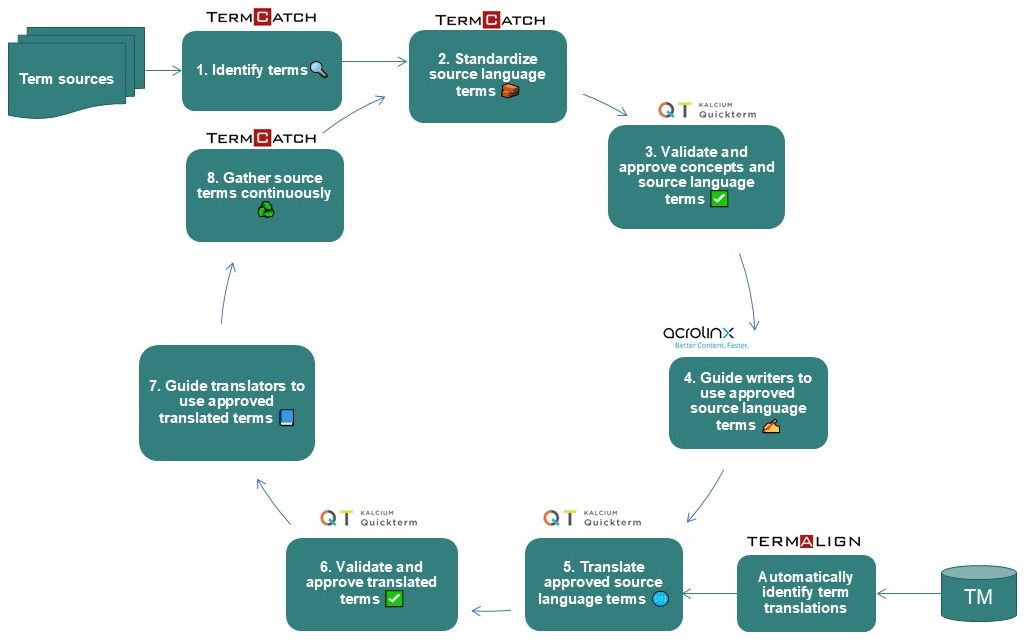Fodina's Wheel of Terminology: How to Make Your Terminology Useful
Terminology is a living thing that needs maintenance. To make it truly useful, you need structured processes behind it. Processes that help you build, maintain, and use terms across teams, languages, and tools. In our daily work, we usually call this the Wheel of Terminology.

At Fodina, we’ve worked hands-on with terminology for over 20 years, across industries, languages, and tools. We’ve seen firsthand how the right processes can transform terminology from a scattered collection of words into a powerful, shared resource. That experience is what shaped the process we use as terminologists ourselves, and what we recommend others to use: The Wheel of Terminology.
Here’s what that wheel looks like in practice:
🔍 1. Identify terms from various sources
Pull terminology from PLM systems, existing termbases like Acrolinx and Quickterm, and industry standards, or harvest them from documents, translation memories, or competitor websites. You can use Fodina’s TermCatch to harvest source terms and group them into potential synonym clusters for easier review.
🧱 2. Standardize source language terms
Work through those identified terms. Choose what terms should be preferred and deprecated, define them clearly, and enter the relevant metadata. The TermAssist feature in TermCatch can suggest both a definition and much of the metadata for you.
✅ 3. Validate and approve concepts and source language terms
Especially in a large organization, the terminologist doesn’t have all the knowledge about all parts. That’s why it’s important to validate that the suggested concepts work for the people who need to use them. This is where the terminology becomes truly reliable. Our partner Kaleidoscope offers helpful features for managing validation workflows in Kalcium Quickterm.
✍️ 4. Guide writers to use approved source terms
Make sure that content creators use the right terms by integrating terminology into their writing environments and content workflows. Our partner Acrolinx offers an effective way to help content creators follow your language guidelines, including using the correct terminology. The approved concepts can also be used to guide engineers (e.g. part naming), or support internal search (“Did you mean…”).
🌐 5. Translate approved source language terms
Once you have standardized and approved source terms that people use, you are ready to translate them. This is to make sure that consistency is carried over into any other languages people may read your content in. You can use Fodina’s TermAlign to extract candidate target terms straight from your translation memories.
✅ 6. Validate and approve translated terms
Just like source terms, translated terms need validation. The translator is an expert in their language, but not in the use of that language in your organization. Therefore, input from internal reviewers who speak that language is also important. This ensures that approved terms are accurate, natural, and usable in your specific context. The result is target terminology that’s not only linguistically correct, but also tailored to your organization..
📘 7. Guide translators to use approved translated terms
Make the approved terminology available where translators work, via CAT tools, termbases, and clear in-context examples.
♻️ 8. Gather source terms continuously
Language evolves. New concepts emerge. We recommend you use TermCatch continuously to keep identifying new term candidates and grouping variants. That way, your terminology stays relevant and up to date.
With the right tools and processes, terminology becomes an asset that supports writers, translators, engineers, and users alike. Not just a hidden-away word list that can’t be found or efficiently used.
Let’s build terminology that works.
Let's talk about terminology!
No matter what your terminology challenges are, we have the expertise and products to solve them.
Terminology
/ˌtɝː.məˈnɑː.lə.dʒi/
The specialized words and phrases used within a particular field, profession, or area of study. It’s the vocabulary that allows experts to communicate effectively and precisely about complex concepts.
